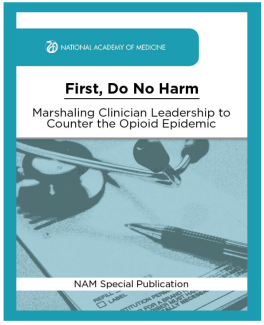National Academy of Medicine Releases New Special Publication Guide

September 21, 2017
Halting the opioid epidemic requires aggressive action across multiple dimensions, including informed, active, and determined front-line leadership from health clinicians working in every setting throughout the nation, says a new National Academy of Medicine special publication developed at the request of the National Governors Association to assist the nation’s governors as they work with clinicians to counter the opioid crisis. Authored by leading national authorities on substance use disorders, the 21-page paper is an action guide for clinicians – physicians, physician assistants, nurses, nurse practitioners, dentists, social workers, behavioral health practitioners, pharmacists, and first responders – if they are prescribing an opioid or managing a patient who presents with a likely opioid use disorder. To successfully marshal progress, the paper calls for clinicians to prioritize non-opioid strategies when managing chronic pain, follow five axioms of responsible opioid prescribing, and promote policies that stimulate and support available scientific evidence.
“This paper speaks in particular to the roles of clinicians, both as primary gatekeepers for the appropriate use of these drugs and as first responders to the consequences of their misuse,” said J. Michael McGinnis, NAM Leonard D. Schaeffer Executive Officer. “Moreover, the paper serves as a call to action for the nation’s clinicians to assume their broader leadership responsibilities and advance the health of the communities in which they live and work.”
“The group of experts who wrote this publication are key leaders from the nation’s scientific, professional, and policy organizations. Only through this sort of collaboration can we make real progress in countering the opioid crisis and its toll on patients, communities, states, and the nation as a whole,” said Victor J. Dzau, president of the National Academy of Medicine. “Clinicians are not expected to make these changes alone. To truly have maximum impact on the health of their communities, they must work with patients and families, community leaders, elected officials, and the business community. All clinicians, regardless of their focus or specialty, must work towards the goal of patient health and well-being.”
Many factors have intersected to drive the rate and reach of the opioid epidemic, the publication says. Prescribing practices have played a substantial role, but those practices have been shaped in turn by circumstances ranging from those medical in nature – such as increases in chronic diseases, new surgical interventions, and professional calls for better pain management – to the influence of market distortions, including large quantities of unused opioids easily accessible in the home. In 2015, about one-third of American adults used a prescribed opioid, with the total number of prescriptions exceeding 225 million, or about 71 prescriptions per 100 persons, according to the Centers for Disease Control and Prevention.
Recognition of the crisis has prompted the development of strong efforts to raise awareness among clinicians of the need for vigilance and counter-action, which is beginning to take some effect. In particular, the recent National Academies report Pain Management and the Opioid Epidemic: Balancing Societal and Individual Risks of Prescription Opioid Use challenges clinicians and health care systems to re-evaluate how opioids fit into the larger array of pain management strategies.
Except for conditions such as cancer, palliative care, and end-of-life, clinicians should first look to non-opioid approaches proven effective for chronic pain control, the publication says. If the realistic benefits outweigh the serious risks of opioids for a given patient, clinicians should use them in combination with other modalities, as appropriate, to provide greater benefits to patients in improving pain and function. In addition, when prescribing opioids, clinicians should follow five axioms that include tailoring the treatment for each patient, employing precautionary protocols, actively managing and monitoring the patient, working as a team with the patient and family, and linking to treatment services.
The publication identifies the range of clinician leverage points important for countering the epidemic and its consequences, including:
- Using a team approach to care, which is especially important in substance use disorders.
- Emphasizing that substance use disorders are treatable chronic neurologic conditions, requiring a sustained, multifaceted approach typical in managing any chronic disease.
- Precautionary prescribing that accounts for individual risk factors and social circumstances.
- Counseling on secure storage and proper disposal of unused opioids.
- Cross-checking the Prescription Drug Monitoring Program registry to identify unsafe drug use behaviors.
- Providing systematic follow-up by the care team for signs of opioid misuse or opioid use disorder.
- Co-prescribing naloxone to patients at risk of overdose.
- Facilitating use of medication, such as buprenorphine, as indicated, for opioid use disorder, including obtaining training and authority for medication-assisted treatment.
- Providing referrals for treatment assistance, as indicated, including follow-up with the referral team.
- Engaging with the community to promote the availability of necessary substance use disorder treatment resources.
To download the special publication, please click here.